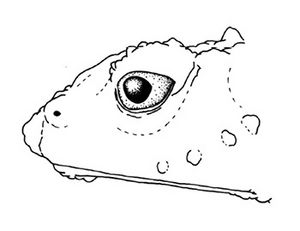Guacamayo plump toad facts for kids
Quick facts for kids Guacamayo plump toad |
|
|---|---|
 |
|
| Head shape in lateral view of female Osornophryne guacamayo | |
| Conservation status | |
| Scientific classification |
The Guacamayo plump toad (scientific name: Osornophryne guacamayo) is a special kind of toad. It belongs to the Bufonidae family, which includes many types of toads. This small toad lives in the misty mountains of Colombia and Ecuador.
It gets its name "plump" because of its rounded body shape. Its natural home is in wet, cool montane forests, which are forests found on mountainsides. Sadly, its home is shrinking because of things like farming and logging.
Contents
What is a Guacamayo Plump Toad?
The Guacamayo plump toad is a type of amphibian. Amphibians are amazing animals that can live both in water and on land. Toads are known for their bumpy skin and often prefer drier places than frogs, though they still need moisture.
This specific toad is quite small. It has a unique look that helps it blend into its forest home. Scientists first officially described this toad in 1987.
Where Does It Live?
Mountain Homes in South America
The Guacamayo plump toad lives in the Andes Mountains. The Andes are a very long mountain range in South America. These toads are found in specific parts of Colombia and Ecuador.
They prefer what scientists call "subtropical or tropical moist montane forests." This means they live in forests on mountains that are warm and very wet, often covered in mist or clouds. These forests are full of unique plants and animals.
High-Altitude Habitats
These toads live at high altitudes, meaning they are found far up in the mountains. The cool, damp conditions there are perfect for them. They often hide among moss, leaves, and other plants on the forest floor. The thick forest canopy helps keep the ground moist and cool, which is important for amphibians.
What Does It Look Like?
The Guacamayo plump toad is a small, rounded toad. Its body is often described as "plump" or "chubby." This shape helps it store water and energy.
Its skin can be bumpy, which is common for toads. The colors of these toads can vary, but they usually have earthy tones like browns, greens, or grays. These colors help them hide among the leaves and dirt on the forest floor. Their eyes are usually quite noticeable on their heads.
Life Cycle and Reproduction
Like other amphibians, the Guacamayo plump toad starts its life in water. Toads usually lay their eggs in strings or clumps in small pools or puddles.
After hatching, the eggs turn into tadpoles. Tadpoles live in the water and breathe with gills, much like fish. They eat tiny plants and algae. As they grow, they slowly change. They develop legs, their tails shrink, and their gills are replaced by lungs.
Once they are fully grown, they become tiny toadlets. These young toads then leave the water and begin to live on land. They will grow into adult toads, ready to reproduce and continue the cycle.
Why Is It Important?
Every animal plays a role in its ecosystem. The Guacamayo plump toad is part of the food web in its mountain forest home. It likely eats small insects and other invertebrates. In turn, it might be a food source for larger animals like birds or snakes.
By eating insects, toads help control insect populations. This is important for keeping the forest healthy. The presence of healthy toad populations can also be a sign that the forest ecosystem is doing well.
Threats to the Guacamayo Plump Toad
Sadly, the Guacamayo plump toad is listed as "Vulnerable" by the IUCN (International Union for Conservation of Nature). This means it faces a high risk of becoming extinct in the wild.
The biggest threat to this toad is habitat loss. This happens when its forest home is destroyed or changed.
- Deforestation: Forests are cut down for farming, logging, or building.
- Climate Change: Changes in temperature and rainfall patterns can affect the moist mountain forests where these toads live.
- Pollution: Pesticides and other chemicals can harm amphibians, as their skin easily absorbs things from their environment.
- Diseases: Some diseases, like chytrid fungus, are a big problem for amphibian populations worldwide.
Protecting these unique forests is key to saving the Guacamayo plump toad and many other species that call them home.
See also
 In Spanish: Sapo de guacamayo para niños
In Spanish: Sapo de guacamayo para niños


